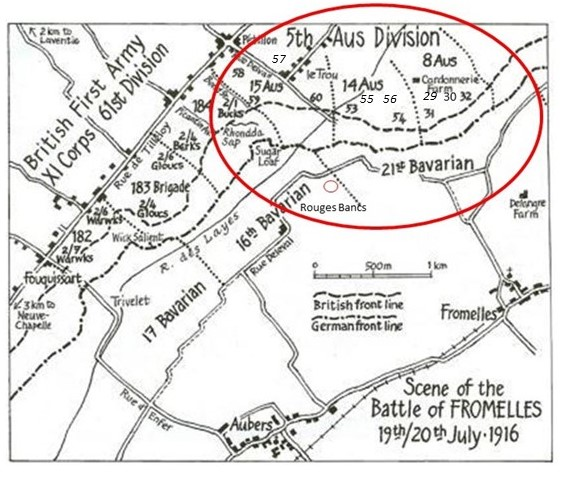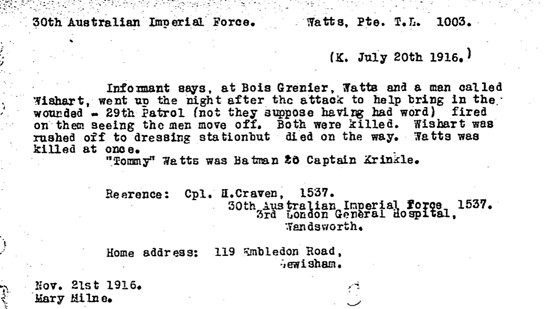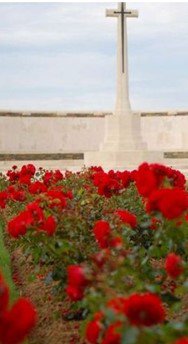John Hay WISHART
Eyes dark grey, Hair black, Complexion dark
John Wishart – Died Saving His Mates
Can you help us identify John?
John was killed in Action at Fromelles, but his body has not been found. There is a chance he might be identified, but we need help. We are searching for suitable family DNA donors.
If you know anything of contacts for John here in Australia or his relatives from Darvel, Scotland, please contact the Fromelles Association.
See the DNA box at the end of the story for what we do know about his family.
We would like to acknowledge the contributions to this story taken from the Commonwealth War Graves Commission’s website, Stories of the Fallen - Private John Hay Wishart 1004, written by Scott Wishart.
Early Life
John Hay Wishart was the seventh of Helen (nee McNab) and John Hay Wishart’s thirteen children, seven boys and six girls. He was born on 14 February 1878 at 71 Dover Street in the Kelvin district of Glasgow. John’s father was a jointer (journeyman).
After John was born, the family moved to Darvel, 45 km south of Glasgow and were living at 87 East Main Street. The 1891 census shows John and eight siblings living at 10 West Main Street. John attended the Darvel Primary School, which was just a short distance from their house. Sir Alexander Fleming, inventor of penicillin went to the same school at the same time as the Wishart family.
John went on to become a teacher and when he was 21 he decided to emigrate to Australia, sailing from London to Sydney on 31 March 1899 on the RMS Orizaba. John eventually settled in Wallsend, near Newcastle, New South Wales. He lived on Nelson Street and worked as a dispenser for Dr H. K. Bean, a medical officer at the Wallsend Hospital.
While he lived in Wallsend for a number of years, he did not marry.
Off to War
With his UK background and the War recruiting efforts well underway in Australia, John visited the Liverpool Sydney recruiting office in Sydney on 10 July 1915 and enlisted in the Australian Imperial Force. As he had a medical background, John listed ‘ambulance’ as a qualification on his attestation papers. He also informed the recruiting officer that he was 34 years old when he was 37, not an unusual practice for the ‘older’ recruits.
While he had medical experience, he was posted to ‘D’ Coy of the newly formed 30th Infantry Battalion on 1 August and sent for training in Liverpool, NSW. On 2 September, John’s unit were moved from Liverpool to the Royal Agricultural Society Grounds in Moore Park, Sydney. There were numerous reports about the 30th in the papers.

Two months later, the battalion, which consisted of 30 officers and 971 other ranks, sailed from Sydney on 9 November, headed to Egypt on board the HMAT Beltana. After the month-long trip, the ship anchored at Suez. They disembarked three days later, caught the train to Helmieh and marched to Aerodrome Camp in Heliopolis.
John’s first seven weeks were spent at Ferry Post guarding the Suez Canal and continuing military training. February and March were at the camp at Tel el Kebir, where they were inspected by H.R.H. Prince of Wales.

For much of April and May they were back in Ferry Post, including some time in the front-line trenches there. There were the usual complaints of the heat, water supplies and flies.
Fromelles
John’s battalion left Egypt for the Western Front on 16 June 1916 on HMAT Hororata, arriving in Marseilles on 23 June. After landing, there was a 60+ hour train ride to Hazebrouck, 30 km from Fleurbaix. They arrived on 29 June and were encamped in Morbecque.
Private F.R. Sharp (2134) wrote home about the trip:
“From the time we left Marseilles until we reached our destination was nothing but one long stretch of farms and the scenery was magnificent.” “France is a country worth fighting for.”
Training now included the use of gas masks and they also would have heard the heavy artillery from the front lines. On 8 July they were headed to the front lines, 20 km to Estaires and then 11 km to Erquinghem, where they were billeted at Jesus Farm. They got their first ‘taste’ of being in the front lines at 9.00 PM on 10 July.

A week later, they got orders for an attack, but it was postponed due to the weather, but on 19 July, the 30th Battalion were into battle. The 30th Battalion’s role was to provide support for the attacking 31st and 32nd Battalions by digging trenches and providing carrying parties for supplies and ammunition. They would be called in as reserves if needed for the fighting.
The 32nd’s charge over the parapet began at 5.53 PM and the 31st’s at 5.58 PM. There were machine guns emplacements to their left and directly ahead at Delrangre Farm and there was heavy artillery fire in No-Man’s-Land. The initial assaults were successful and by 6.30 PM the Aussies were in control of the German’s 1st line system (Trench B in the diagram below), which was described as “practically a ditch with from 1 to 2 feet of mud and slush at the bottom”.
Source: AWM4 23/49/12, 32nd Battalion War Diaries, July 1916, page 11

John’s company had initially been assigned the job of repairing communications and escorting prisoners. While their role was to be in support, commanders on scene made the decision to use the 30th as much-needed fighting reinforcements. When the 30th was formally called to provide fighting support at 10.10 pm, Lieutenant-Colonel Clark reported:
“All my men who have gone forward with ammunition have not returned. I have not even one section left.”
Fighting continued through the night. The Australians made a further charge at the main German line beyond Trench B, but they were low on grenades, there was machine gun fire from behind from the emplacement at Delangre Farm and they were so far advanced that they were getting shelled by both sides.
At 4.00AM the Germans began an attack from the Australian’s left flank, bombing and advancing into Trench A (map). Given the Australian advances that had been made earlier, portions of the rear Trench E had been left almost empty, which then enabled the Germans to be in a position to surround the soldiers.
At 5.30 AM the Germans attacked from both flanks in force and with bombing parties. Having only a few grenades left, the only resistance the 31st could offer was with rifles:
“The enemy swarmed in and the retirement across No Mans’ Land resembled shambles, the enemy artillery and machine guns doing deadly damage.”
The ultimate total was that 122 soldiers of the 30th Battalion were either killed or died from wounds and of this total 80 were missing/unidentified.
What Happened to John?
John survived the main battle. C.E.W. Bean, in his Official History of Australia in the War of 1914-1918, gave details of John’s role in the battle.
“The machine-gunners and others, who throughout the night had blocked the enemy’s way up the Kastenweg (a German trench on the left flank), had received no order to withdraw, and, being left alone and counter-attacked from all sides, most of them were overwhelmed and shot down or captured. Captain Krinks’s post, however, in the craters east of the trench was missed by the enemy.
Being close in front of the Farm (Delangre Farm) and situated on the same rise, its occupants could see what was happening on the lower ground in their rear on both sides of the Kastenweg. Realising that they were cut off, and being eleven in number, they decided – after debate – to make a run for it together rather than separately, and to assist any among them who met with trouble.
Leaving their arms, and trusting to surprise, half of them succeeded in crossing two enemy trenches, each containing Germans. In the second trench two of their number were seized; but the remainder instantly turned round, as they had arranged to do, scared the Germans, released their comrades, and escaped with them into No-Man’s Land, Krinks and three comrades eventually reaching the front of the 60th British Brigade.”
He goes on to write in a footnote:
“This daring escape had a sad sequel. The men who reached safety with Krinks were Corporal A. H. Mc L. Forbes and Private J. H. Wishart (both of Wallsend, NSW) and Private T. L. Watts (of Hurstville, NSW); but two others, L/Cpl. S. B. Wells (of Wollongong, NSW) and Private E. C. E. Amps (of Coff’s Harbour, NSW), had got clear of the German trenches, but in the wire-entanglement, Wells was shot down and Amps injured”
The 30th Battalion immediately after the fight was sent to reserve, but Krinks and his three companions returned to the trenches as soon as it was dusk, and, taking a stretcher, went out into No-Man’s Land to find their comrades. In this they succeeded and were bringing in Wells on a stretcher when a sentry of their own brigade, catching sight of their figures, fired, killing Wishart and Watts with a single shot.”
There were four Red Cross Witness statements about this incident and a stirring article by Chaplin B. Wilson – “We suffered many casualties, but the death of these two brave fellows was a great shock to the company and every man felt it very keenly.”

Thomas Watts’ body was initially buried at the military cemetery near the dressing station and was reburied later in the Rue Petillon Military Cemetery. The Red Cross report cites that John died while being taken to the dressing station, but, surprisingly, given the details of his actions from the rescue, there are no records of him being buried.
John’s body has never been found. John Spooner, a cousin of John’s, wrote - Wishart, Watts and Wells had joined up together and had consecutive service numbers. Forbes was from the same town as Wishart and also enlisted on the same day. There were obviously very close bonds of friendship. Captain J. Chapman described John and Thomas Watts:
“we could never have struck two finer boys.”
While John had no family in Wallsend, he was clearly respected in the community.
John was awarded the 1914-15 Star Medal, the British War Medal, the Victory Medal, a Memorial Plaque and a Memorial Scroll.
He is commemorated on Panel 3 of the V.C. Corner Australian Cemetery and Memorial in Fromelles, the Darvel War Memorial in Scotland, and the Wallsend WW1 Roll of Honor in New South Wales.

Can John Be Found?
After the battle, German soldiers removed 250 Australian casualties from the battlefield, burying them in a large pit near Pheasant Wood. This mass grave was not discovered until 2008. Identification by DNA matching has been ongoing since that discovery as potential relatives have been able to located.
To date (2024), 170 of the 250 soldiers from the grave have been identified, including 26 of the 80 missing soldiers from the 30th Battalion. While John was not killed in the advanced lines, he still remains unidentified. Contact is especially sought with descendants of John’s siblings, who perhaps may still be living in or near Darvel, Scotland.
Family connections are sought for the following soldier
| Soldier | John Hay Wishart (1878 – 1916) |
| Parents | John Hay Wishart (1842 - 1911) b Glasgow d Darvel Scotland and Helen McNab (1847 - 1937) b Newton Mearns Scotland |
| Siblings | Jane (1867 - ) | ||
| Catherine (1869 - ) b Glasgow Scotland, m John Young | |||
| Helen (1871 - ) b Glasgow Scotland | |||
| Peter (1872 - ) b Glasgow Scotland, m Elicabeth Hamilton | |||
| Nelly (1874 - ) b Glasgow Scotland m Robert Boyes | |||
| Finley (1876 – 1967) b Glasgow Scotland, d Border Cumberland England, m Jean Morton | |||
| Hugh (1880 - ) b Darvel Scotland | |||
| Janet (1881 - ) b Darvel Scotland, m David McGeachie | |||
| Duncan (1884 - ) b Darvel Scotland, m Lil | |||
| James (1886 – 1967) b Darvel Scotland, d Haslingden Lancashire England, m May Scott | |||
| Mary (1888 – ) b Darvel Scotland, m Frank Crocker | |||
| Margaret (1892 – 1984) b Darvel Scotland, m Frank Crocker |
| Grandparents | |||
| Paternal | Peter Wishart (1804-1874) b Killearn Scotland d Glasgow Scotland and Catherine Hay (1806-1879) b Glasgow Scotland, d Loudon Scotland | ||
| Maternal | Finlay McNab (1825–1904) b Pollok Scotland d Darvel, Scotland and Jean Hamilton (1823- ) b Newton Mearns Scotland) |
The Fromelles Association would love to hear from you

Contacts
(Contact: carla@fromelles.info or geoffrey@fromelles.info).
(Contact: army.uwc@defence.gov.au or phone 1800 019 090).
Donations
If you are able, please contribute to the upkeep of this resource.
(Contact: bill@fromelles.info ).




